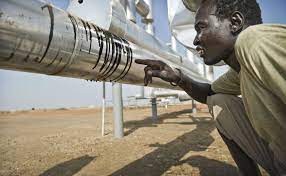Sector organization
In South Sudan, two main entities oversee activities in the petroleum sector. The Ministry of Petroleum and Mining is responsible for managing South Sudan’s petroleum sector.[1] The National Petroleum and Gas Corporation (“NPGC”) is the main policymaking and supervisory body, and it reports directly to the president and national legislative Assembly. The NPGC participates in all segments of the hydrocarbon sector and approves petroleum agreements on the government’s behalf.[2] The Nile Petroleum Corporation (“Nilepet”) is South Sudan’s national oil company. Nilepet oversees operations in the petroleum sector, and because of its limited technical expertise and financial resources, it holds minority stakes in production-sharing contracts with foreign oil companies. South Sudan’s Transitional Constitution, the 2012 Petroleum Act, and the 2013 Petroleum Revenue Management Act define the regulatory framework governing the hydrocarbon sector.[3]
National oil companies (NOCs) based in Asia are the major foreign oil companies in the oil sector in South Sudan. The China National Petroleum Corporation (CNPC), India’s Oil and Natural Gas Corporation (ONGC), and Malaysia’s Petronas hold large stakes in the leading consortia operating in South Sudan. The leading consortia operating in South Sudan are the Greater Nile Petroleum Operating Company, the Dar Petroleum Operating Company, and the Sudd Petroleum Operating Company.[4]
Table 1: Main oil companies in South Sudan[5]
| Consortium or subsidiary | Company | Country of origin | Share percentage |
| Greater Pioneer Operating Company (GPOC) | CNPCPetronasONGCNilepet | ChinaMalaysiaIndiaSouth Sudan | 40.0%30.0%25.0%5.0% |
| Dar Petroleum Operating Company (DPOC) | CNPCPetronasNilepetSinopecTri-ocean | ChinaMalaysiaSouth SudanChinaEgypt | 41.0%40.0%8.0%6.0%5.0% |
| Sudd Petroleum Operating Company (SPOC) | PetronasONGCNilepet | MalaysiaIndiaSouth Sudan | 67.8%24.2%8.0% |
Petroleum and other liquids Exploration and production
According to the Oil & Gas Journal (OGJ), Sudan and South Sudan collectively held proved oil reserves of 5 billion barrels, as of January 2022.[6]
Most of the crude oil in Sudan and South Sudan is produced in the Muglad Basin and Melut Basin.[7] Sudan and South Sudan produce three different crude oil blends: Dar, Nile, and Fula.[8] The Dar blend (25.0° API gravity, 0.11% sulfur) is a heavy crude oil with a low sulfur content.[9] It also has a high total acid number (TAN) and corrosive qualities that can make it difficult for refiners to process.[10] The Dar blend is produced at Blocks 3 and 7 in the Melut Basin, which is controlled by South Sudan. The Nile blend (33.9° API gravity, 0.06% sulfur) is a medium, waxy crude oil produced in the Muglad Basin at Blocks 1, 2A, 2B, 4, and 5A; its crude oil characteristics make it a relatively more attractive blend to refiners because of its high fuel and gasoil yields.[11] The Fula blend (21.0° API gravity, 0.14% sulfur) is a highly acidic crude oil produced in the Muglad Basin at Block 6 and is processed for domestic use.[12]
South Sudan launched its first-ever licensing round in 2021, offering five exploration licenses, through which the government hopes to attract a diverse group of foreign investors to stimulate upstream investment and increase its crude oil production.[13] The government was to collect expressions of interest until August 23, 2022, and will likely organize investor events later in the year to provide more data and transparency for the blocks on offer.[14]
During the forecast period of 2022–2027, the South Sudanese oil and gas market is anticipated to grow at a compound annual growth rate of almost 1.5%, rising from 134.7 thousand barrels per day in 2021 to approximately 146.7 thousand barrels per day by 2027. The GDP index for South Sudan decreased by 1.69% in 2020.[15]
The government of the Republic of South Sudan and the government of the Republic of Sudanentered into a number of agreements to cooperate across a range of areas of common interest and committed themselves to implement these agreements, including “The Agreement on Oil and Related Economic Matters(AOREM),” is expected to increase political stability and drive the market. “[16] It is expected that the market will be driven by the increasing investment during the projected period as a result of greater political stability.[17]
[3] Petroleum Act, Laws of South Sudan, Ch. II–V, 2012. Also, Laura M. James. “Fields of Control: Oil and (In)security in Sudan and South Sudan,” Small Arms Survey, HSBA working paper 40, November 2015, pg. 18. “Energy Capital & Power Re-releases Africa Energy Series: South Sudan Report,” Energy Capital & Power, October 8, 2021. David K. Deng. “Oil and Sustainable Peace in South Sudan,” South Sudan Law Society working paper, February 2015, pg. 3–5, accessed July 13, 2022.
[4] “Energy Capital & Power Re-releases Africa Energy Series: South Sudan Report,” Energy Capital & Power, October 8, 2021.
[5] Data Source: Global Energy Monitor, Fitch Solutions Country Risk & Industry Research, Energy Capital & Power, small arms survey.
[6] Oil &Gas Journal, “Worldwide Look at Reserves and Production,” [Table], December 2021.
[12] “South Sudan: Dar Blend,” Energy Intelligence, June 1, 2021. “South Sudan: Nile Blend,” Energy Intelligence, June 1, 2021. “Sudan: Nile Blend,” Energy Intelligence, June 1, 2021. Angelia Sanders. “Sudan and South Sudan’s Oil Industries: Growing Political Tensions,” Civil-Military Fusion Centre, May 2012, accessed July 13, 2022. Mohamed Osman Khalil, “Processing of High TAN Crude Oil in Khartoum Refinery: a Unique Experience,” UNCTAD presentation at 17th Africa OILGASMINE in Khartoum, November 23 – 26, 2015.

